Wayne C. Allen's Blog, page 9
February 25, 2024
On Being Seen

On Being Seen — it takes a bit of effort to watch ourselves story-making, and to let that go long enough to see and be seen

My first and most popular book,
This Endless Moment.
Learn to live a full and satisfying life.
I remember being in some workshop somewhere and spotting a friend across the room. We met up after the gig was over, and she said to me something to the effect of, “Isn’t it nice to meet up with a member of your real family?”
Later, that got unpacked as an expression of how good it feels to look over the heads in a crowd and “recognize” someone that you are simpatico with.
All of which has to do with being seenThe photo at top was taken in the bus station in Liberia, Costa Rica. The young woman was staring off into space; then she’d focus in on the guy in front of her, then she’d sigh, and look sad.
I watched this for a bit, then ended up taking a picture, and when I blew it up, she seemed to be looking right at me.
I take a lot of photos of people, as this blog is relentlessly in need of them. Lately, I’ve been using my quite good cell phone camera, and the downside is that I can’t really tell what I’ve got until later. Plus, it has the disconcerting habit of shooting the photo several seconds after I hit the button, so images are often a surprise.
Anyway, I was amazed that she seemed to be looking right at me, and in a sense seeing to and through me. I saved the shot, and it occurred to me that it ws perfect for this article.
I have a sense that the feeling we get when we think that we “click” with someone is likely hard-wired into our genes, and also, it’s not very reliable.In Zen, we talk about form and emptiness, and also about how we “identify” with stereotypes. By identify I mean that we make determinations about the character of others based upon smoke and mirrors.
For example, I notice a predilection in myself to “like” Canadians, and to have all kinds of judgements about people from the US of A, despite being from there myself. I left decades ago, and like to forget that my formative years in the States ever happened. One of our weirder friends knows this, so he continually apologizes in my presence for making disparaging remarks about the US, despite the fact that I self-identify as a Canadian, and have lived in Canada since 1975.
And up goes my back.All of this has nothing to do with anything other than the stories I tell myself, and the fact that my “quasi-friend” likes to poke at people to see if he can get a rise out of them. This doesn’t work without the cooperation of the “pok-ee.”

Our inner reactions to things we provoke ourselves over can’t be helped.
It’s what the Buddha called monkey mind. Our minds can barely stand not chattering–leaping from branch to branch–going after the “better” fruit. We all do it; we just need to notice.
So, have another look at the lead photo. See if you can tell yourself a story about the guy, the girl, the situation. Let your imagination run a bit.
See? Monkey mind.Where it goes all topsy-turvy is when we give validity to the stories we create.
And even if we could walk into the photo and ask the young woman what’s on her mind, we’d only get the part of the story she decides to share.
Same thing with the initial illustration–the one about “meeting our tribe.” That kind of “soul-mate” stuff often gets shoveled in group meetings, especially if the group can be in any way construed as being a collection of “aren’t we special” folk. We create a story about our specialness, flesh it out, and then desperately want to add others to the mix.
It’s the same process that causes us to think we are in love.Hormones signal attraction, and rather than going “Wow! I’m turned on!” we go, “This is true love!” And once that bridge is crossed, for many couples the rest of their time together is an often futile attempt to turn the partner from who they really are into who we think they ought to be.
Being seen, on the other hand, has very little to do with either trying to fit yourself in somewhere, or trying to make others fit into some dopey story. Being seen is dropping the games and the stories, and simply being honest–both with yourself and with others. Being seen makes little of the games our heads are playing, and a lot of simply opening the doors to being honest.It’s treating fellow humans as the unique beings they are, while ruefully watching our little heads try to mash them up and fit them in a box.
Clearly, true intimacy is about this kind of dialogue: here is who I am right now, here is the story I am telling myself, and now that that’s out of the way, what’s up for you?
Less certainty, more curiosity.Not easy, not fun; it’s hard work to keep the monkey mind in the background while opening yourself to self and other scrutiny.
But hey, most people feel lost and alone and misunderstood, right?
So, maybe another way of interacting is necessary.
And that, always, starts with you.Facebook TwitterFebruary 18, 2024
On Being Connected
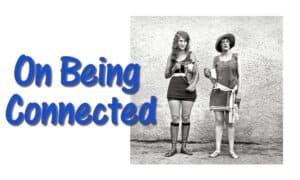
On being connected: it’s tricky, relating without judging. It takes effort and presence. But it’s a learnable skill!
 Psst! Hey!
Psst! Hey!** Want more great writing designed to help YOU to shift your behaviour?
** Want to learn how to find, build or deepen your principal relationship?
** Want to know more about Zen living and being?
So, there’s a big field across from our old condo in Sámara, and for many years it was the home of a herd of horses. Except at Xmas, when a bull ring is added, as well as food booths, and there’s a festival.
Out of the blue one year, the field suddenly had cows.
Including Brahmans. See photo, above. Anyway, this breed has floppy ears, obviously, and they look you in the eyes as you pass by. I mean, they stare right at you. I posted the photo to Facebook, and captioned it, “Who is looking at whom?”
Of course, who knows what the cow is thinking?But there’s something there… some internal connection, I think. Not that I’m looking for cow‑y friends, but more so that there’s a hidden connection, as in “everything is connected.”
OK, so my real point is that everything is connectable. If we choose.Our ability to connect or not, to be clear or not, to see through to the essence of another… has nothing to do with the other person, (or the cow, but that’s another article  )
)
Before I retired, I spent inordinate blocks of time helping clients drop their stories and games, so they might relate without attachment.
By this, I mean, to notice how easy it is to slip into our heads and away from the reality of the connectable moment that’s right in front of us.
In Buddhist thought, the essence of awakening is noticing when I bring myself out of connected curiosity. When I promote my judgements and stories over curiosity, I cease “relating with,” and find myself relating (if you can call it that) at the straw person I have imagined.
On the other hand, there’s resonance… and a smile.
I think this is how we really learn to trust our ability to connect. When I find myself interested and curious, the differences between me and another seem to go background.
Not away. Background. Nothing goes away.It’s like people objecting that they can’t meditate, because they can’t stop thinking.
Well, of course not! Our judgements are unceasing… we even do it asleep. But as we sit and notice, we see that the thoughts and stories are fleeting, and not at all interesting, important, or true. So, we sit some more, and let go. And the thought drifts away, and another and another and another takes its place. Each of equal un-importance.
The same with our principal relationships.The reality of the other person is only in their moment by moment activities. Each of us is as we do. The descriptions we attribute to the actions we see (or hear, etc.) have nothing to do with the other person, despite our passion for believing them.
So, when I see someone do something and say, “I don’t like [that action] about them,” that really has nothing to do with the other person. I am reacting, and then placing my reaction ahead of the reality of the other person.
When we fight, same thing, with more intensity.When I fight with someone, I have a more heated annoyance going on, but again, it’s totally about me and my stories.
So, once again, it’s about me and my judgements.I think it’s a good idea to remember that. To be honest, and say, “I disagree with that person, according to my beliefs,” rather than, “That person is wrong, and an idiot besides.”
It might be fun to spend some time going inside and seeing how judge‑y and preachy you are. Notice how you wind yourself up, make the “other” wrong, and then settle into sanctimoniousness. Notice how divisive and silly this is.
And how easy it is to just have a breath, and let those thoughts slide.
Ultimately, some people resonate for us, and others create an opposite vibe, and most are somewhere in the middle. It might be interesting to accept this, and spend energy nurturing the resonating connections, noticing the neutral ones, and gently walking away from the ones we are not comfortable with.
All without making anyone bad or wrong.Because that is just a waste of time and energy.
Facebook TwitterFebruary 11, 2024
Zen and Simple Presence
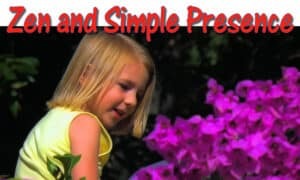
Zen and Simple Presence — waking up is not all that hard to do, but it does require paying attention, which many find… hard to do! What is simple isn’t so simple.
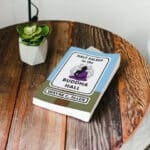
Looking for more on this topic?
Check out my book, Half Asleep in the Buddha Hall.
Wayne’s “Eastern” book takes you by the hand and helps you to find peace of mind. Half Asleep in the Buddha Hall is a Zen-based guide to living life fully and deeply.
Perhaps one of the hardest things to “get” about present and focused living is the mechanics of how it all works. This topic is so important that I wrote a book about it.Half Asleep in the Buddha Hall uses Zen stories as starters for each of the chapters. Here’s an example:
A guy named Harry is on a quest for enlightenment. He tries everything. He goes to school. Nada. He becomes a life coach. More nada. He worships in the local shrine-of-choice. Mucho nada.
Desperate, he decides to climb a mountain in Nepal, to visit His Holiness, Rama Dama Ding Dong. It is an arduous trip. (Aren’t they always?) Finally, near death, he collapses on the ground near a steep path. He looks up, and sees an old man walking down the path, carrying a big bundle of firewood on his back.
Harry says, “I’m looking for Rama.” “I am he,” replies the guru. “Oh, thank god!” Harry says. “I’ve been searching for so long. Please, tell me, what is ‘waking up’?”
The guru takes off the bundle of wood, sighs deeply, and smiles. In that instant, Harry woke up.
Then Harry’s mind got involved. He asked, “Please, pardon another question, but what do you do after ‘waking up’?”
Rama picks up the bundle, places it on his back, and continues down the hill.
One step, and one step, and one step, until you die.

The ease, the simplicity… it’s actually a matter of non-complicating things. Because dealing with things in a non complex way leads to… peace, clarity, and no little amusement.
It’s my friend in this photo, dangling her shoe. The process is simple, if you let it be simple.
Simple presence allows us to experience life moment-by-moment.
This is emphatically not what most people do. Most people, by getting caught in a “thought loop,” quickly drop out of “the now.”
Let me illustrate… and this is something I cover in my book, This Endless Moment):
The things that occur in our lives are simple events, phenomenon, or stimuli. (You pick a name.) They are essentially meaningless (meaning that they lack intrinsic meaning.)
Now, you may want to rush in and say, “Hey! Stuff has meaning!” And you would be right. It just doesn’t mean anything in its essential nature. In other words, everything, including us, derives meaning from a human being.
Each and every thing means what the person (each person) makes it to mean.This is the process of interpretation, or judgement. We all make them, all of the time.
There is absolutely nothing wrong with our judgement process. In a sense, we’d be dead without it. It is, after all, what tells us not to pick up the glowing fireplace poker.
A Zen teacher, Adyashanti, used this illustration (which I’m paraphrasing):

“A poisonous snake crawls up a man’s arm. The non-present person thinks, “Oh. My God! A snake. I wonder if it will bite me. What should I do?” The snake bites him and he dies. The awake, aware, and ‘present’ person simply flicks off the snake.”
Where the problems come is when a judgement occurs… and instead of simple action, we, (like the snake bitten man,) stop, lose presence and go into our heads to universalize and awfulize.
It’s “It will always be like this. This is a terrible situation, and terrible situations always happen to me. Why can’t I ever meet the right man? Why do bad things keep happening? I must be a bad person. No, I’m surrounded by bad people. Why do I attract bad people?”
Snake bit. Dead.All of that internal chatter happens, and then we might anger ourselves or scare ourselves over the story we invented. This leads us to either attack or run away. In order to do this, I have to go into my head, away from the present moment, and start chewing on the data.
In the mean time, the world has moved on, and the data might no longer be relevant.
I receive a stimulus, I interpret it, I may also notice simultaneous emotions. In that moment, I have two choices,
I can say, “Hmm. Here’s what appears to be up for me. I will act (speak, not act, report, share) in this way, thus staying present.”I can immediately go non-present, and start playing back awfulized stories, which add to my personal drama. This only accomplishes confusion, mis-direction and inaction (or wrong action.)See? I said it was simple.Now, a lot of “special” people out there are going to argue with me, based upon their thinking that I do not understand their “special” circumstances, background, DNA, situation, partner… whatever. But you see, all of that is irrelevant.
All there is, are the circumstances in front of you, and your choice. It’s not about anything, it doesn’t mean anything, and no one else can do anything to change your internal representation, or change what you are about to do, or not do.
Rama Dama Ding Dong did not bemoan picking up the wood. He didn’t complain about his sore back. He didn’t blame his parents for not being rich so someone else could carry the wood for him. He didn’t blame his wife for not using the communication model.
He picked up the wood and walked.
Being present is this. I will always judge and evaluate. This is the way it is. The purpose of judgment is to go: “Snake!”
And then brush the snake off.Being Present is this. My actions are consistent with my walk. I act clearly and cleanly, without blame or drama. There is nothing I have to do or learn before I can act with simple presence. Simple presence is a here and now focus, choice and perception.
I know many people who begin this path, and then scare themselves with the intensity of the experience and take a year or a lifetime off. Therefore, remember: all you have is now, and this walk requires one thing – walking.
Facebook TwitterFebruary 4, 2024
Zen and Emotional Balance
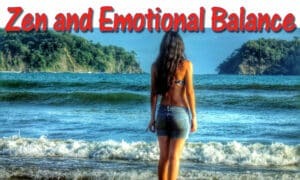
Zen and Emotional Balance — there’s nothing “Zen” about blocking emotions. In fact, Zen is all about being real, which means being elegant — including elegance in your emotional expression.

Looking for more on this topic?
Check out my book, Half Asleep in the Buddha Hall.
Wayne’s “Eastern” book takes you by the hand and helps you to find peace of mind. Half Asleep in the Buddha Hall is a Zen-based guide to living life fully and deeply.
Let’s talk about Emotional Balance, shall we?We can make a few universal assertions about emotions:
we all have them,we all hurt ourselves if we do not express them, andwe all hurt ourselves and deepen the mess we are in if we express our emotions in a non-helpful way.Zen prizes balance, and the best way to do this is to be present with our process. While many people equate balance with “neutral,” and therefore with “lukewarmness,” we think that a life well lived is more like the story of Goldilocks and the Three Bears.
Too hot, too cold, just right!Let’s pretend that Goldilocks is a Zen teacher, and look at emotions from the perspective of her three categories.

Too hot: Rather than get into a big head trip about how we generate emotions, let’s just say that they “arise.”
We must also accept that emotions are all ours — others (or externals) do not cause us to have emotions. Emotions arise as we participate in life, and are completely and totally self-generated.
Too hot emotions are emotions that spill all over the place, and are usually covered in blame. Or perhaps better put, too hot emotions are delivered in the context of blame, while justifying the delivery by saying one is incapable of controlling them.
We hear, “It’s all your fault I am so angry, and there’s nothing I can do about my anger, because this is what I learned from my parents.” or, “I am so unhappy that you won’t do what I want you to, so I’m going to find a way to punish you for what I imaging you have done.”
Blah, blah, blah.
The problem with too hot emotion is that they burn everyone. They are never justified, but sure are they popular! Hotly expressed emotions, like a pile of manure in the living room, are pretty hard to ignore, and need shovelling before life can return to normal.

Too cold: Too cold emotions are repressed emotions.
There is a tightness about repression, and especially when emotions are stuffed over time. There is a biting off of the emotions, and thus a tight jaw. There is a disengaged quality to the person’s approach to life.
While people think there is something noble and restrained about repressing emotions, the result is internal turmoil, and often, illness.
Included in this is passive aggressiveness — acting as it nothing is wrong, but using silence and coldness as a bludgeon to get others to cooperate. Common, but not helpful.

Just Right: a balance. Emotions are felt internally, named, and expressed safely and with clarity.
It’s funny how few people reach a balance point in their lives, and especially when it has to do with emotions.
Most are stuck at either of the above poles, and rapidly swinging between the two.
The balance point, the “just right point,” is this:
This, of course, is a tricky walk, as no one prepares us for it.I choose to safely and cleanly express my emotions without aiming them at anyone or anything. I say what I need to say, at the right volume, using “I” language, and making it clear that I am accepting responsibility for my beliefs, my emotions and my reactions.
Indeed, our society sells us either or both of the other two positions.
It’s also tricky because it requires that I stay “simply present,” and aware of my self all the time (which is how one balances anything, including life.) With no one and nothing to blame, including myself, I am simply responsible for my life, my fate and my direction.
Now, oddly and paradoxically, the more you practice this Zen-based middle way, the less you will find yourself needing to engage in emotional dumping. You’ll find that not many emotions are worth the time and energy needed to express them. You’ll notice them building, coming forward, receding and passing. Like clouds.
This differs entirely from “too cold.” Too cold is a forced repression of emotions.
“Just noticing” is letting what happens, happen. It is seeing everything and attaching to none of it. Or, as a modern Taoist might think, (cf. Stewart Wilde)
“The way it is, is the way it is.”
This week, notice your approach to your emotional life. Too hot? Too cold? Too much of both?
Re-imagine your life as “just right.” Hmm.
What a concept.
Facebook TwitterJanuary 28, 2024
Zen and Karma

Zen and Karma — karma is not a system of rewards and punishments, or even a “what goes around comes around” philosophy. It’s a statement that all things are interrelated, and results have causes.

Looking for more on this topic?
Check out my book, Half Asleep in the Buddha Hall.
Wayne’s “Eastern” book takes you by the hand and helps you to find peace of mind. Half Asleep in the Buddha Hall is a Zen-based guide to living life fully and deeply.
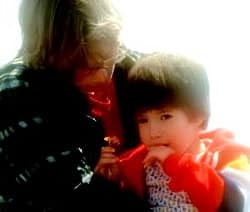
In his book “Body Mind Balancing,” OSHO describes our “disconnect” from our bodies; needless to say, a topic of some interest to me.
He wrote that we are conditioned, as infants, to be miserable and needy. He then wrote that the opposite emotions or feelings — bliss or happiness — are looked upon, at the least, with suspicion.
Pleasant, placid, happy babies often get less attention than a baby that is squalling, squealing, and constantly complaining.
He thought that this predisposes kids to think that misery is the key to getting attention. (I have to say it: think Trump! His entire life is based upon just such a whiny, picked-upon position.)
As you walk down the street, you are much more likely to see bland, blank, or scowling faces – and you likely think this is normal. Seeing someone walking toward you smiling and laughing to himself seems, well, threatening or perverse.
Let’s just agree that we are predisposed to looking on the gloomy side of things – to looking for what is wrong – either with externals (“My diaper pin is poking me!”) or internals (“I’m hungry. I’m thirsty. I’m bored. Fix me! Fix me!”)
And then, folk get into a relationship… and each demands the other person’s total attention and endless deference. Since they are both doing it, it boils down to this: the two children can’t get along.
One of the main things to “get” is that we create every aspect of our own reality, and I mean every aspect. Another way to say this is “our life consists of our karma.”In Buddhist teaching, the law of karma, says only this:
For every event that occurs, there will follow another event whose existence was caused by the first, and this second event will be pleasant or unpleasant depending upon whether its cause was skillful or unskillful.’
A skillful event is one that is not accompanied by craving, resistance or delusions; an unskillful event is one that is accompanied by any one of those things. (Events are not skillful in themselves, but are so called only by virtue of the mental events that occur with them.)
http://tibetanbuddhistencyclopedia.co...
Therefore, the law of Karma teaches that actions produce results; the result of any action is born by the person who commits it.
Now, the normal description of karma typically includes the idea of past lives, as in, “I must have done something really bad in my past life to deserve this.” I’d like you to put that aspect aside, as this is not even close to the actual intent of the word. It’s just a complication, and the last thing you need is some other distraction to keep you stuck.
Karma is not a punishment. It’s simply an explanation of cause and effect.
What this means is that you are (we all are) a closed system. What goes on inside of you is “all you, all the time.”
For example, no one makes you angry — a situation occurs, and you either anger yourself, or you do not. This is why one person has one reaction and another person has another reaction, when dealing with the same situation.
The feelings that arise in you are neutral. If you simply watch the feeling, it dissipates, (a reason to meditate). If you label and judge the feeling, then you begin to cling.
To what? To the story you invented about the feeling. For example, if you think people are out to get you, you’ll add a “victim” story to the feeling, and blame someone or something.
And even this is not Karma.
If, then, you decide to tell off the other person, or pull a sob story, or whatever, now you’re generating Karma. Because what you do generates a reaction or response. Your action led to a reaction (even the reaction of ‘no reaction,’) and your Karma is to deal with what you have created.
As an exercise, I want you to stop, right now, and think about all aspects of your life, including:
Money or debtJob or vocationRelationship(s)How you view your sex lifeView of yourself (self-image)Your main daily focus (is it positive or negative)How’d you do? How are you feeling about yourself, your life, and your relationships?
Now, here’s the karma piece:
Every single aspect of everything you just thought about is a direct result of your past decisions, choices, and “paths chosen.“
Not part of it, not most of it, but every single bit of it.
But in order to move on, to finally reach a point of purposeful peace and contentment, you have to accept total responsibility for every aspect of your life: You caused it, you set it in motion, and you made it happen. If you will not accept this reality, you will remain a perpetual victim.
Your life is exactly and precisely what you made it and make it to be.Where you are right now is the result of your past choices, and your present mood and temperament have a lot to do with where your head has been for the last year. Thus, today was set in motion by you last year!
And because you are so good at imagining and planning out imaginary scenarios, you unconsciously committed to being where you are right now, and have denied any evidence to the contrary to what you believed and set in motion.
The way out begins, of course, today — how you think and what you tell yourself, today and from now on.If you want a different life a year from now, you must begin right now. And you must put as much energy into what you want (the new path) as you have put into what you believed and did in the past. No excuses.
Let me be clear. I am not suggesting that you substitute blaming yourself for blaming everyone else.Blaming is not an action, it’s an addiction! The key is to accept that you are who you are as a product of your choices, and to simply move on by acting differently. No blame, just self-responsibility.
When Darbella and I led training events, we always started by playing The Eagles “Get Over It.” Here’s the last verse:
It’s like going to confession every time I hear you speak
You’re makin’ the most of your losin’ streak
Some call it sick, but I call it weak
You drag it around like a ball and chain
You wallow in the guilt; you wallow in the pain
You wave it like a flag, you wear it like a crown
Got your mind in the gutter, bringin’ everybody down
Complain about the present and blame it on the past
I’d like to find your inner child and kick it’s little ass.
The time is now, and now is when we make things new again. If you don’t like where you are, change your karma. In this moment. No blame. No excuses.
Facebook TwitterJanuary 21, 2024
Zen and Clinging

Zen and Clinging — Clinging is what causes suffering, or so said the Buddha. This idea is not so hard to understand, until we are… well… suffering. Then, we just want it to be over. And that’s how we go off the rails.

Looking for more on this topic?
Check out my book, Half Asleep in the Buddha Hall.
Wayne’s “Eastern” book takes you by the hand and helps you to find peace of mind. Half Asleep in the Buddha Hall is a Zen-based guide to living life fully and deeply.
Most people are plagued with clinging.Clinging is “grasping onto.” We can grasp on to an actual thing, or to an idea. We can also grasp on to “aversion” — to not wanting something. In general, clinging us about identifying with ideas — “this is me, this is not me.”
Something I cling to might be called the “object of my desire.”Zen attempts to loosen our fingers from the death-grip we have on the object(s) of our desire, so that we can accept the final paradox of our desire – you can never hold on to anything, including our illusions.
The problem is simple — clinging demands that my desire should trump my reality.Many of us are quite capable of being present — when all is well and the creek ain’t rising. Difficulties happen when we face a reality that differs from what we imagine we want.
It’s like the old joke: The 8‑year-old speaks for the first time: “Mom! The toaster is on fire!” Mom’s amazed: “Why has it take you so long to speak?” Kid: Everything was alright until now.”
Zen, too, seems kinda easy, right up until something goes wrong: illness, death, someone leaves you… Then, it’s: “This is not satisfactory! I want this to be over!”
Let’s start by having a look at desire, shall we?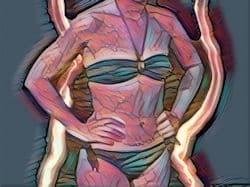
There’s a book by Mark Epstein called “Open to Desire.” Epstein is a Buddhist psychotherapist, and was a student of Ram Dass.
Obviously, the subject of the book is desire, and how Buddhism has a bit of a split personality about it. We do too, of course.
Desire, like sex, makes many people uncomfortable.
We like it that things can and do “turn us on,” but we also realize that turn-ons have “power over us.” And turn-ons mean that there are turn-offs; things that we don’t want. They’re still desires, or better, anti-desires.
Epstein describes two paths in Buddhism.The ‘right hand path’ as that of the ascetic. In this view, all desire leads to trouble (suffering)… and the way to deal with it is to repress it, fight it, ignore it, or meditate it to death.The ‘left-hand path’ is Tantra. In this view, desire becomes the energy for transformation. Desire stands in the gap between what we have and what we want.There are several things going on here at once, and they’re all contradictory.
First, desire is a function of objectification.
One of the exercises featured in my book, This Endless Moment is to go to a Mall or a beach or some place where lots of people are. Sit there and watch the people go by, and notice which people you are attracted to. Just notice.
If you do this with your partner, tell him or her what you are learning about yourself.
Just below the surface, we all crave, or desire, “others.” Here is the first paradox.
In order to desire, I have to create an-other — an “ object of my desire.” In order to desire, I have to see the object while holding it as a thing.The paradox is that full-blown desire only happens when I objectify. As soon as the object becomes a person, as soon as I give the object subjective reality, (I recognize the person) the charge… the desire to fade.
Second, desire is an internal mental process — the object of your desire is inside of you.
This is part of the point of the observation exercise. You judge someone to be desirable. Another person, sitting next to you, might not think so. Thus, the person observed is NOT desirable (it’s not a characteristic of the person); you desire the person.
As you take a step back, you realize that there is a gap between what you desire and the reality of the object. The paradox is that you want to possess and hold on to something you are imagining… (the real issue is, as we shall see – clinging…) – but the reality of what you are trying to hold on to has a mind (or a nature) of its own.
Epstein writes:
“But this kind of satisfaction is impossible because the qualities that we project onto the desired object — of permanence, stability or “thingness” — do not really exist… The disparity between the way we perceive things and the way they actually are is at the root of our struggle with desire. Once we learn to make that disparity part of our experience, however, desire can be a teacher rather than an affliction.” [p 69]
The Buddha’s first teaching is called “The Four-fold Path.” This teaching supposedly happened pretty much right after his enlightenment, and discusses his major insight — that desire (or better, clinging to desire) leads to suffering.
The Buddha thought that our propensity for creating suffering was so common that his First Truth was, (as it is typically translated in English) Life is Suffering.
Epstein says that the Sanskrit dukkha, (the word usually translated ‘suffering’) actually means something closer to “pervasive unsatisfactoriness.”
An example of dukkha is a potter’s wheel that is off-balance, and therefore continually squeaks.When you are miserable, isn’t that what life feels like — like something’s not quite right, annoying, irritating, anger-provoking?
The problem comes when we feel this sense of dukkha, and then blame the experience on persons, places, or things outside of ourselves. We blame others (or our situation — pain, etc.) for creating the feeling we have inside of us, despite at some level knowing that our feelings are always and exclusively an inside job.
The second Noble Truth: “Clinging (to misplaced desires) causes Suffering.”The Buddha was a pretty good psychotherapist, and he spent his life describing elements of this dance. What he determined was that desire in and of itself is not an issue. Clinging to the thing we desire is the issue.
We cling to what we imagine we want, as opposed to being with (desiring) what we have. We create dukkha when we prefer our imaginings over reality, which is how suffering happens.The place where desire exists, however, is also the place where we can begin to step out of the world of things. As we allow the “things we desire” to just be — to become real, separate and subjective, we can embrace both their separateness and their deeper meaning.
Now, that’s not what we think nor how we normally act. We label everything, and most especially do we judge everything.Thus, it might be said that all suffering comes from our attachment to what we think someone (or some thing, more precisely) ought to be, as opposed to learning to deepen our desire for how “it” actually is.
The same thing happens at the intra-personal level, as we objectify our lives.This time was better than that time.This experience is preferable to that experience.This is a good desire, that is a bad desire.In each case, I am creating a straw person who is leading a life other than the one I am experiencing, and I cling to my desire for that (unreal) reality. Boy, this suffering is a pain…
Boy, this suffering is a pain…Of course, if I am sick, I’d rather not be. I can easily remember all the times I felt ‘better,’ and boy do I desire that “other” feeling.
But this simply leads to compounding my pain with my imagined suffering .
A way to think of this is that pain is inevitable: things we want won’t happen, things we don’t want will, and the bodily reaction is pain. The Buddha patiently explained, however, that suffering is always optional.
Ram Dass used this illustration at a workshop: “Imagine that you have to have burning coal placed on the palm of your hand. This is pain. The question is: will you hold it loosely, (non-clinging) or will you grasp it tightly (suffering) and burn your entire hand?”
Not easy, this, because when we hurt, we want “it” to go away. To change. To be different. And yet, each thing has its own time-frame, and doesn’t care what we want.
If we deal with the pain “as it is,” we do not suffer. If we focus on what we aren’t getting, and demand change, at the very least, we are disappointed.
The way though is being passionate about only one thing. This Present Moment.
Passion is the way to open ourselves to encountering the other (person, place, thing, experience) as real. This type of relating is an internal decision to be passionately engaged in an exploration of the gap that exists between myself and that which is other. I also explore the gap between another and my perception of the other.
So, what is the gap, and how does it parallel desire?The gap is created by the space (and the emotional tension) between what is happening and what I wish would happen.
In most cases, this tension creates desire – a longing for ‘what isn’t.’ This desire is either positive — “I want what I don’t have,” or negative — “I don’t want what I do have.”
Where most go off the rails is when they freak out over the tension. They endlessly try to “make-over” the person or situation – the ‘object’ of their desire – into the image they have in their heads.
To state it again — the desire for something “other” is normal. The demand that “that which is desired” become real — that what I desire internally be created in the world — simply because I imagine it to be “better” — is clinging — which leads to suffering.
Clinging to one’s demand for “what I am imagining” leads to ‘spending one’s life fighting the gap.’ A desire that one obsesses over leads to misery. If I ‘fixate’ on fulfilling my desire, I will never have a moment’s peace.
The ‘right hand path’ suggests dealing with our propensity to cling by rejecting or renouncing desire.The left hand path, the way ‘through’ desire, is to accept it, respect it, and use it to work with the gap.So, what does this look like?Oddly, it’s as simple as acceptance. I accept that nothing stays the same, that there is always a gap between what is and what I desire, and I use this tension to relax into being comfortable with my discomfort. What is will soon be something else. Obsessing about it (“You! Change NOW!”) simply means I cling to my desire, and I suffer.
The best description is this (repeat as a mantra, if you will):
Life is in endless tension. That is the nature of life. The way through the tension is to simply be present with it in a non-grasping way.I am who I am, and my discomfort is a part of that. If I observe it as opposed to clinging to it and pretending it’s real (it’s not – it’s a figment of my imagination), the distress will lead me to notice what I am doing, and allow me to step away from doing to simply ‘being in the moment.’
Once I see that life is as it is, I can learn to be in my life, as opposed to trying and failing, endlessly, to fix it, either in time, or by making everything over in the way I want it to be.
Once I stop trying to play god, in other words, I can simply be me.
Like I have another choice…
Facebook TwitterJanuary 14, 2024
Zen and Innocence
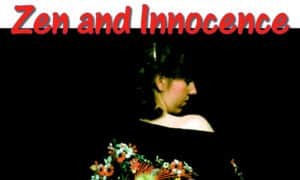
Zen and Innocence — finding a place of childlike innocence allows us to interact with life, rather than analyze it.

Looking for more on this topic?
Check out my book, Half Asleep in the Buddha Hall.
Wayne’s “Eastern” book takes you by the hand and helps you to find peace of mind. Half Asleep in the Buddha Hall is a Zen-based guide to living life fully and deeply.
There’s this thing about Zen: it flies in the face of conventional “wisdom.”For example many are the stories of Zen masters, in the middle of life-threatening situations — stopping to admire (or eat!) a strawberry. Here’s one version:
One day while walking through the wilderness a man stumbled upon a vicious tiger. He ran but soon came to the edge of a high cliff. Desperate to save himself, he climbed down a vine and dangled over the fatal precipice. As he hung there, two mice (one black, one white) appeared from a hole in the cliff and began gnawing on the vine. Suddenly, he noticed on the vine a plump wild strawberry. He plucked it and popped it in his mouth. It was incredibly delicious!
The western concepts of “urgency and importance” are disturbed by a story such as this. How can it be, in the midst of this serious situation (Tigers! Oh! My!) that he would eat (and enjoy!) the strawberry? And yet…
Remembering and using the skill of coming to a full stop is a useful way to approach our lives differently.
A friend recently mentioned watching his three-year-old child. Right in the middle of something, the child would do a “full stop;” she would freeze in place, her eyes would glaze over, and then, a second or two later, she’d snap back to “here,” and carry on.
My friend decided that the child was making a new neurological connection.
Of course, this is how children do behave.
None of us remember being a young child. We do not remember being born into a world about which we had no clue — we were born as tabula rasa — blank slates. We were born as receivers. Our sense organs were open to some degree (for example, it takes months for a baby’s eyes to truly focus) and our brains were empty sponges.
We began to add in data — but it was raw data. It lacked meaning. Data flows in and initially — perhaps for three or four years — much or all of this data is new – or better, being experienced by the child for the first time.
So, the child must turn to adults for interpretation.
Remember, the child has no context (prior experience) to judge a new experience. Context develops over time. So the parent I described above is correct; his child was “zoning out” in order to categorize. The “zoning out,” was the child turning off external stimulation to make a neural connection regarding a new experience.
But what the experience means is up for grabs.To repeat, meaning is initially provided by adults. As children, we learn what others believe to be so, and because we, as children, have no innate beliefs. So, we buy into the belief system of our “tribes.”
Because nothing predates this tribal interpretation, it becomes our deeply rooted belief system. Everything, from then on, is vetted through — and attached to — this primary belief system. This happens without exploring the truth of the initial belief(s). We believe our foundational truths are true… because we believe them to be true.
These baseline beliefs are not based upon evidence.They are based upon … well … nothing! Weirdly, most people never examine these beliefs — they go through life filtering their ongoing reality through un-examined beliefs.
For this reason, Buddha (might have) said,
“Do not believe in anything simply because you have heard it. Do not believe in anything simply because it is spoken and rumored by many. Do not believe in anything simply because it is found written in your religious books. Do not believe in anything merely on the authority of your teachers and elders. Do not believe in traditions because they have been handed down for many generations. But after observation and analysis, when you find that anything agrees with reason and is conducive to the good and benefit of one and all, then accept it and live up to it.”
Let’s revisit this: What the Buddha suggested is not what most adults do. Most have never questioned their baseline beliefs.
And then, to complicate matters, we think that what we believe is also true. We believe it so fervently that, even though what we believe leads to suffering and pain for ourselves and others, we still believe it and do it.
It’s as if our heads harden at age five, and that’s it. “Here is who and what and how I am, and there is nothing I can do about it!”
Well, yes, there is an alternative, although it is difficult.It is called adopting a practice of innocence.Innocence comes in two flavours: You have seen children running off in all directions. They are doing that because they crave new experiences. They know that the only way to learn new things is to have new experiences. They have not (yet!!) shut off their curiosity. They rush ahead, and damn the consequences.
This is a description childish innocence. It is reckless, and lacks reason.
Child-like innocence, on the other hand, happens when a reasoning and functional adult explores the world (inner and outer) with complete openness and total freedom.
The freedom of child-like innocence is freedom from prejudice.Prejudice simply means “pre-judgment.” It is believing that I already know what something means, what it will feel like, what will happen, how someone “always is.” It is a load of crap, but we believe it. Prejudice keeps us from experiencing life in with child-like innocence.
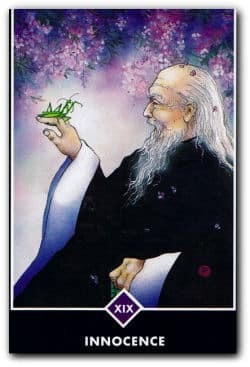
The monk in this card from the Osho Zen Tarot deck is demonstrating what I am talking about. He is totally engaged with the praying mantis on his finger. He is fully and deeply present in the moment, without prejudice.
And, he is clearly happy.
One mark of the state of innocence and bliss is a smile. It is getting the joke that my life is what I make of it, and is precisely how I define it. In innocence, my experiences are devoid of meaning, (until I add them,) and there is no requirement that I do so!
I can “be” in my experience.
And the joke is, you are in your experience, whether you notice or not. This is the Zen of today’s article. You cannot escape your experience. Torturing yourself and suffering over your experience is a function of judgment and prejudice, and it entirely optional.
I am “in” my experience; if I am also awake to it, then whatever is going on is simply what is going on.Life is incredibly short, and much of it is wasted in endless justifications for staying stuck in old thought patterns and habits. The old, old stuff is not removable. It’s just there. But, and here’s the key, it can be dealt with.
For instance, when you were four, there likely was an absolute rule that you were never, ever, to cross a street without holding an adult’s hand. I trust you’ve moved past that rule by now! Yet, that “life or death” rule is still in there, and likely no one ever told you specifically to disregard it. You outgrew it.
It is now time to outgrow all the stuff you shovel that keeps you stuck and miserable.Not by rooting it out or by getting someone’s permission to let it go. You outgrow it by acting in another way. Metaphorically, it is now up to you to look both ways before crossing, but to cross the damn street!
Growing up means letting go of childish things. Letting go of what is not working, by doing what does work. Having experiences because they are available to you. Having full body relationships because you want to. Having new thoughts and new experiences each and every moment. And this is only possible by being in the moment (you are anyway!) with attention and focus.
Do it, now. And enjoy the adventure! Even with tigers above and tigers below, the strawberry at hand is delicious!
Facebook TwitterJanuary 7, 2024
Zen and Clarity

Zen and Clarity — learning to see clearly is key to creating peace and focus. Zen offers us many opportunities for clear seeing.

Looking for more on this topic?
Check out my book, Half Asleep in the Buddha Hall.
Wayne’s “Eastern” book takes you by the hand and helps you to find peace of mind. Half Asleep in the Buddha Hall is a Zen-based guide to living life fully and deeply.
I’m continuing the series of articles featuring my peculiar twist about Zen — how a “Simple Presence” approach to life might be of use to you in these most turbulent times.
Zen tends to turn our understandings on their ear, by insisting on the reality of no realityIf you’ve read my book, This Endless Moment, you’ll remember that I wrote that the most important concept to ‘get’ is that there is no real reality.
What this means is that stuff is happening — in the world, in our lives — as we grow, mature, and change. The stuff that is happening, however, has no intrinsic (built in) meaning. It just is.
The way we interpret what is happening is entirely personal AND optional.The process of interpreting ‘just happens’ as we observe the world around us. We perceive a ‘thing that is happening.’ Our natural process is then to ascribe a category to the thing we perceive.
This is a good thing — we have, for example, a category for ‘hot’ things — like a glowing stove top. It’s great to know that this category applies to all glowing stove-tops.
The trouble comes when we take it a step further, and add in a meaning (an interpretation, or judgement)This is the realm of right and wrong, good and bad. Should. Shouldn’t.
The words themselves are not the issue. The issue is clinging.
The Buddha said that suffering is caused by clinging. By this, he meant that we get attached.
The attachment is to the “rightness” of our view, and especially do we cling to the “wrongness” of the views of others.
And yet, the things we cling to are stories we’ve made up — fictions — they are not a part of the thing itself.To wake up is to both understand and accept the intrinsic meaninglessness of everything around us, including the stories we tell ourselves. This is tough, as we have a lot riding on being right. On being smart. On being “the one with the answers.”
We are invested in our stories, and our investment is in our stories, and in the stories we create back up the beliefs we’ve created.Life discomfort comes when how we interpret events does not match what is actually happening ‘out there.’
And that begs the question: when I feel discomfort, do I blame ‘out there,’ or do I question my interpretation?
Let’s step through our process: we see an event, and rather than stay cleanly engaged with the event per se, we start to run a script based upon stories we have told ourselves in the past.
Example # 1: if I believe that I am incapable of having a meaningful and lasting relationship, this story will colour each and every transaction I have with my partner. If I am not conscious that I have created this story, I will find myself doing two things:
noticing any event that supports my story, andignoring every instance the denies my story.Or, I may believe that my role in life is to explain life to my partner or child – to ‘help’ them to ‘see the light.’
Now, if we are talking about a real child – say someone under 12 or so, then yes, our job as adults is to keep the child safe, fed, dry, housed and clothed. We are also responsible for socializing the child, so that he can fit in to the culture to which he belongs.
Where this falls off the rails is when parents continue to parent their adult kids – endlessly interfering with them. “You are not happy, and I have to fix you.”
Or, one spouse decides their partner is ‘a child,’ and the ‘parent’ partner then engages in an endless tirade designed to get their partner to behave (to mind their “mommy.”)
All of this seems reasonable to the person doing this because they think they know best for another. They are unwilling to deal with the actual person – they want the other person to shift so they can be comfortable.
What’s odd about all of this is that the other person typically isn’t asking to be fixed!
And you can’t fix another person anyway. It’s hard enough to fix ourselves.
Example #2: Many people think that waking up is ‘about’ rooting out all that is ‘wrong.’ Typically, such people trap themselves into assigning blame. They are looking to figure out who to blame for their dilemma.
Parents typically get a lot of blame. “If only my parents had been different, had been better role models, had treated me differently.”Partners, past and present, are also blamed. “Why doesn’t she understand? Why can’t he grow up and act right? If only I’d picked better.”Such reflections lead precisely nowhere. The reflections are based upon stories we tell ourselves, and not upon present reality.
Our first admission needs to be this:
Our memories are notoriously unreliable and self-serving. Our sub-conscious minds ‘selectively pull’ “memories” to support what we already believe!
And even if the story we tell ourselves is essentially ‘true,’ (dad was a jerk and mom was an enabler, or whatever…) so what? Is knowing that likely to change anything in the here and now?
Who you are right now, is … wait for it … who you are right now. There is no way to change one iota of your past. You can’t get a better deal, can’t change your upbringing, nor can you change a single decision you ever made.
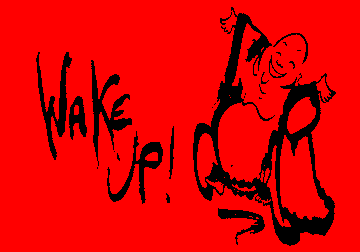 What you can do is wake up.Waking up involves stepping out of the dream.
What you can do is wake up.Waking up involves stepping out of the dream.The dream is the story you tell yourself.
I’m abused. I’m hard done by. I’m a victim. He is the jerk, I am the princess. I have to get everyone to believe my side of the story. Everyone hates me / is out to get me. How people perceive me is important.And on and on. The dream is you, living on auto-pilot, repeating the same lame behaviour, day after day, decade after decade. And never, ever, accepting responsibility for your behaviour.
Waking up is seeing the game for what it is, and choosing, repeatedly, to walk another path.Rather than doing away with our stories (we can’t) we find new ways of thinking and being.
For me, the Zen approach is best. This perspective is very much oriented toward being present without judgement and without preconceived notions. I engage with what is happening now, and in this way my behaviour is relevant to the here and now.
When I take this approach, all that matters is what is going on in this moment.
I choose to let go of the past – all of the ‘trying to fix things,’ all of the ‘assigning blame.’ In this moment, I can choose to see and hear and interact, or I can choose to let the situation or person go, for now or for forever.
I can make that choice based upon where I am right now, as opposed to making the decision based upon the past.
Here’s a quote from Zen Body-Being, by Peter Ralston:
“The success of our actions depends entirely on our ability to relate appropriately to what is actually occurring in this moment.”
And here’s the key:
“Notice that the principle is not based upon what we perceive or experience. This may not make sense unless we recognize that there is a discrepancy between our perception and what is occurring. In short, we can perceive something other than what is there, and fail to perceive what is actually there.” [p 151]
In other words, what we think is going on is just what we think is going on. It’s not what is actually going on.
I remember once, sitting with a couple. The woman told me at great length, and with sighs and tears, what her husband thought about the topic at hand.
I asked her if she was interested in actually asking him what he thought, as he was sitting right next to her. It turned out that she was interested, and asked.
‘Strangely enough,’ he thought exactly the opposite of what she thought he thought! And she’d been mad at him for a week, because she ‘knew’ what he was thinking, and … well, you get the point.
We begin to move past all of this by getting our noses planted on our side of the fence. I do not know what Darbella is thinking, doing, wanting, desiring.
I can tell myself a story and interact with her as if my story is true. Or, I can ask her.
Guess which one works?
Facebook TwitterDecember 31, 2023
Recharging and De-cluttering for 2024
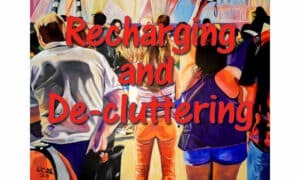
Recharging and De-cluttering — 10 Ways to Make 2024 a Year filled with promise and a centered perspective

Want to learn more about living a full and meaningful life?
Want to have the best relationship ever?
Check out my books
Not that we really need holidays to justify dealing differently with our lives, but since the opportunity is here, let’s take it.
Part of my motivation comes from the oddly weird days we are living in. I wonder how long things will go on before some seismic shift occurs — I think something’s on the horizon. Mostly, we don’t want to hear that, and pretend that if we keep the same old balls in the air, we’ll preserve and persevere.
I wonder why we think we can continue to treat the world and each other with distain, and that somehow things are joust “going to work out.”
Below, some interesting tasks for 2024 that you might consider.
1. Simplify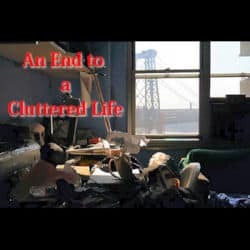 photo by diametrik (modified WC Allen)
photo by diametrik (modified WC Allen)You ever notice how much ‘stuff’ you have? Junk piled in basements… clothes that you just might be able to fit into again? Books you’ve read and will never read again?
Friends, lovers, relatives that you keep hanging out with out of habit?
Beliefs that you cling to, despite their being outmoded and ineffectual?
Start a “pitching stuff out” campaign.
Walk through your space and look for meaningless piles. Then, make a list, say a room a week, and just start dealing with the piles. Give away what you can, have a garage sale, and pitch the rest. Then move to the next room.
People become collectible items too.
Just because you are related to, in relationship with, or married to someone, does not mean that the relationship is destined to last forever. Here’s a good opportunity to visit a therapist. If you think you are clinging to a friend, partner, or relative because you don’t know how to leave, talk to an expert and see if your instincts hold under scrutiny.
The plain fact of the matter is that, as time goes by, we become different — we shift. So does everyone else.
People we are in relationship with may not be shifting along with us… and the wider the gap, the more it hurts, and the more effort must be expended holding things together. If, after reflection, you realize you are caught in such a pattern, think about making 2024 the year of cleaning your relationships house.
Weed Your Beliefs
Still believe in good luck, magic, wish fulfillment, or ‘rescue from the sky?’? Still believe institutions, politicians, big business? Still believe that anyone interested in collecting money from you is doing the collecting in your best interest? Get over yourself. In 2024, examine your beliefs.
Ultimately, simplification is more than a moving of piles. It’s a way of being that is light, efficient, and self sufficient.
Drop the beliefs, the blind faith, the trusting others to look out for you, and build a spine, gain ‘a pair,’ and stand forth as a whole, complete and ‘simple’ human adult.
Talk about being in rarefied company!

Here’s an opportunity to clean yourself out.
Time to get back into shape.
Many of us tend to consume in order to feel “full” — and we do so because we judge our lives to be empty.
Needless to say, the junk food industry is built on this premise. Sugar and carb highs are built in… and such things are mildly to strongly addictive. We eat ’em because we’re hooked.
Yet, it’s amazing how many people buy junk food and then can’t figure out why they are eating it. I was having coffee with a friend, who was complaining that her kids only ate junk. I said, “Hmm. I didn’t know 6 year olds shopped.”
See point 1, above. Clear all the garbage out. Do not replace it with new garbage.
While you’re at it, clean out your attitude. No point bad mouthing or blaming yourself.
Most people get into ragging on themselves for the mess they are in, and then do more of whatever they did in the first place, to compensate for feeling bad.
Let go of the griping, finger pointing, etc., and simply start.
Same thing goes for exercise, getting a massage, doing some Bodywork, etc. Get yourself worked on. Pound yourself into shape.
Haul your butt out there, and hand it over to people who can help you clear and clean out. No excuses.
3. Make Manageable Resolutions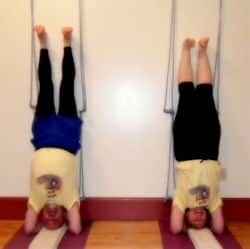
Emphasis on Manageable. Most people make these odd lists of things to change, and then try to do everything at once, and of course, fail miserably.
If you look again at the first two points, you’ll see a pattern, and it is this.
Decide, right now, that 2024 is the YEAR you transform all aspects of yourself. In stages. With delicacy and care.
Projects are best accomplished when broken into bite sized pieces.
Back when I counselled at the University of Guelph, man Masters students came in during January, whining about having to write a thesis. Most were science majors, and needed to write 100 pages. (I laughed, as my thesis topped out at 297 pages.)
I’d say. “You do not write a thesis. You take a page and type “Introduction,” on it, and go on from there, word by word.” Everything is accomlished step by step. We forget this.
Look at the list of things you want to accomplish. Break each one down into manageable chunkettes, stick dates on the chunks, and do them! One by one. Cross them off as you accomplish them.
4. Develop a Practice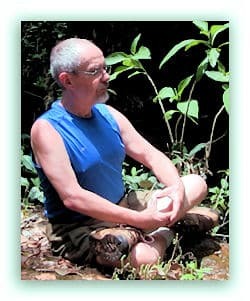
Grounding is key to living life fully and passionately.
Most people flit around in their heads — thinking, plotting, and planning. And they get nowhere. Our culture seems to be heading more and more into the head, away from the heart, away from the soul, away from physical practice and centeredness.
The key to centered living is to actually find your centre — and here’s a hint — it’s inside of you!
Rather than land in there and “just sit” with yourself, we are drawn into our heads for explanations.
I’ll not identify her, but a woman of our acquaintance told us her widow’s hump (bad posture) was due to her job, and to staring at a monitor all day. She swore she was going to “do something.”
I came across a photo of her from 10 years ago, before her job, astride a horse, and with exactly the same weird posture. Hmm.
The first step we recommend is meditation, and the second is Iyengar Yoga.
Look for a local Zen center. You don’t have to become a Buddhist to sit. Zen is not a religion — it’s a way of living, being, and engaging. Primarily, it uses body techniques to still the mind and to being your attention to your whole, complete self.
We are also fans of Iyengar Yoga, and Tai Chi is also a good thing for grounding.
 Darbella made this!
Darbella made this!Most people are so busy running around in circles that they fail to bring creativity into being. All of us have talents — for most, they never see the light of day.
Paintings don’t get painted (or they remain hidden in the extra bedroom…) stories remain unwritten, beauty remains hidden in the dark recesses of scrambled minds.
Think about what you’ve wanted to bring into being.
Create amazing relationships. Once you’ve cleared the decks of the dud and dragging relationships, commit to only excellent relationships, from now on. Learn and use a communication model. Speak using “I” language. For more ideas, check out this article.
Go play. Hang out with your favourite people.
Have fun. Play games, and laugh. Be encouraging, reach out, make physical contact, and let the people you care about know you love them.
Create a beautiful, secure, and serene environment. Chaos in your space equals chaos in your life. Clean your room, hang up your clothes, stop being a slob. Make pieces of art and decorate your house. Set up a little shrine and keep in uncluttered and clean.
6. Stop ComplainingCheck out the “Complaint Free World“campaign.
Have you not noticed that complaining doesn’t work, and only gets you more of what you complain about? Knock it off. Right now.
THEN, change what is changeable. Some stuff can only be changed by others and all you can do is ask, politely, and then let it go. Anything that has to do with you (the stuff we’re talking about this week) is something you can change — either directly, or by describing it differently.
Live your life as you want to live it, and walk away from conflict. Just refuse to play that game.
Very quickly you will see the conflict end,
as one sided fights are impossible.
Don’t complain about your health, ever again. Do something. Try other approaches — eastern approaches, therapy, Bodywork, whatever.
When your body needs a shift, shift.
Complaining only brings you more of what you complain about.

Or risky. Or scary.
Find a way to challenge your fears, including your fear of losing control.
This is a biggie for many. You can learn to let go through dance, martial arts, acting classes, learning to give and receive a full body massage, going to a spa, and through countless sports and outdoor experiences.
Travel. leave the false safety of North America and see other parts of the world. Skip the guided tours and go meet people.
This is your only ‘go-round’ and it’s a big world filled with really interesting experiences. Stop waiting for the right moment or for ‘permission,’ ask for what you want, and go get it, feel it, have it, savour life lived full bore.
8. Make a DifferenceOK. Fair warning. The next points are political, and a bit of a rant. Necessary in my opinion. I’m interested in yours!
Stop trying to blend in — please!
Stand for something, have integrity, and be inspiring. The world is stuffed to the gills with small, petty, mean spirited people, who love nothing more than to rain on other’s parades.
Since you’ve cleaned those sort of folk from your life, now is the time to show the world who you are.
Get out there. Be of service. Teach your skill set to others.
Demonstrate authentic living - don’t just talk about it. Your life is your masterpiece, your life is who you are. If you don’t like aspects of your life and your self, add those things to the list, and make a plan to do things differently.
Be relentless.
Step by step, declare yourself as a free and independent being, living your truth, committed to your values, and a person of your word. There should never be an excuse for being any different than you declare yourself to be, never a reason to betray your self and your path.
9. Be SteadfastThis year’s list is meant to be life changing. In the past, you’ve likely given up and stopped trying. This year, keep going. If there are setbacks, give yourself a hug, and start again.
Reset your goals (paper is cheap) and go for it.
If you find you’re bogging down, find someone to talk with. Encourage your friends, and accept encouragement from them.
Do not yield to the temptation to give up, to get by, to settle for less than you are and who you are becoming. Not this year, not ever again.
The world needs you to walk your path, step by step, inch by inch, as each person who so commits changes the energy of the world, just a bit. Giving up when the going gets tough is for wimps and sissies.
Put on your adult pants and get it done.

Remember: No One Is Coming.
No one is going to marry you and sweep you off to Never Never Land.
We live in a world where fools strap bombs onto their bodies and kill people, maiming in the name of stupid, asinine causes.
In a world where power and force is valued more than strength and integrity, being anything less than a realist is a chump’s game.
Realism lies between optimism and pessimism. Just as airy fairy rescue thinking gets us nowhere, lying down and sniveling in fear is equally non-productive.
The realist says, “Here is my world, and it is exactly as weird and nasty as it appears. It is also magnificent and loving. It is exactly as it seems.”
“I can’t change the world . However, how I am in this world is completely my choice.”
You are not forced to join the fools and idiots (lemmings all) in a race to jump off the cliff.
Stuart Wilde, who was one of my favourite prophets, counselled “walking rapidly in the other direction.”
I agree. Walk your own path. Set your own goals and directions, decry the foolishness and madness, and refuse to get sucked into it.
Killing the killers simply means more killing. Build a life of centered, ethical, passionate presence, and invite others to join you.
Abhor violence, and stand your ground. Do not cave in, do not move an inch from what you know to be right… for you.
As Gandhi said, “Be the change you want to see in the world.”
Think of Lincoln, John & Bobby Kennedy, Martin Luther King, Gandhi, Mandela, Steven Biko, and countless other “walkers of this path.” Many died walking, at the hands of “the dark side.” Yet, each touched and shifted the planet, just through the force of their presence.
Each of us, in our own way, has a similar chance to make a difference, but only if you do what you be. The ripples may not be world changing, but are no less significant. Stand for something, and have it be something other than “The one with the biggest pile when they die, wins.“
Give up piling and ducking, stand forth, and be the change you want to see.
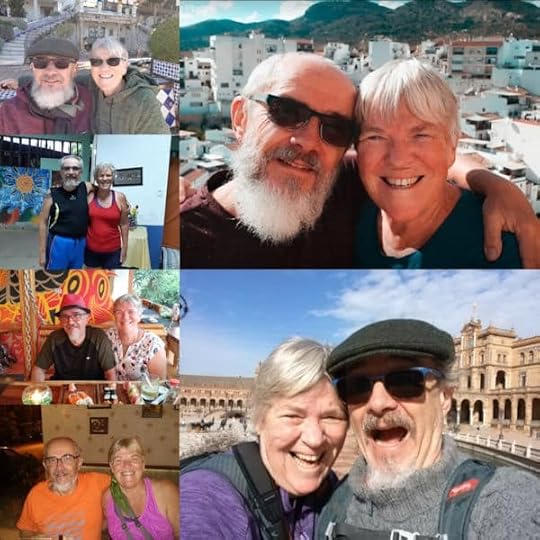 With boundless metta from Wayne & Darbella!Facebook Twitter
With boundless metta from Wayne & Darbella!Facebook Twitter
December 22, 2023
Blue Xmas

Blue Xmas — The holiday season is a high stress time, due to our inability to say no. We might best explore other, more simple approaches, and let go of the drama.

Looking for more on this topic?
Check out my book, Half Asleep in the Buddha Hall.
Wayne’s “Eastern” book takes you by the hand and helps you to find peace of mind. Half Asleep in the Buddha Hall is a Zen-based guide to living life fully and deeply.
Back in the day, some friends ran a “Blue Christmas” service just ahead of Dec. 2–5. I never quite “got it,” despite all the statistics about increases in depression, etc. this time of year.
The other biggie was that many people, apparently, really miss their dead family members at Christmastime.
I had never noticed any particular bump in my client load in December — if anything, client load went down, so it all seemed a bit like an urban Myth.
Earlier today, though, I was reading a blog post, and the author was asking, “So, how are you doing?”
He was asking because he noticed an overindulgence in buying, drinking, etc.He suggested that all of the drama cooked up was likely a lead-in to the Seasonal Blues… and that much of the overindulgence was “about” trying to ignore our self-created pain.
Add to that the dubious joys of family gatherings, spending time with relatives you’d rather not see, reliving events you either don’t remember or are sure happened some other way.
You might not even celebrate Christmas (like Darbella and me) but obligate yourself to show up and be merry for the sake of, say, your parents or siblings.
So, how are you doing?How are your relationships holding up?How much strain is the Seasonal nuttiness creating? or better put, how much drama are you creating for yourself?
As I wrote last issue, it’s been decades since Dar and I pulled the plug on spending… we used to spend thousands (yes, thousands…) on each other.
I take responsibility for it.
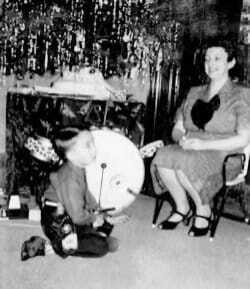 “How about if I bang the drum with my gun?”
“How about if I bang the drum with my gun?”I’m an only child and was spoiled rotten. I couldn’t find a great picture of Xmas glut, but the one here is me, around 4 or 5, gun in hand and drum set in the background, being “properly” adored by my mother.
I suppose I would have gotten 20 or 30 presents, and then another boatload on January 3, for my birthday.
I was well into my 40s before I could let go of the tradition of excess. Dar hooked herself on it too.

I did come up with a photo from the mid 90s. I’d painted a portrait of Dar, and we photographed it. The stuff to the left of the photo is 1/2 of the gifts we’d purchased for each other, and it is stacked up 2 feet high.
Who’s in charge of your seasonal reality?Growing up, my mom, bless her soul, used to describe herself as a “Christmas person.” She dictated every aspect of the holidays, not only at home, but at church, where she co-opted the decorations for the whole church.
And it was a huge church. There were not one but two Xmas trees, each 20 feet high. Mom would go nuts decorating them, as dad and I climbed 25–30 foot high ladders to make her dreams reality.
One of her classics was the Tree of Sin and The Tree of Salvation. The first was decorated and lit in red (red apples, red tinsel, and a big red serpent made out of garland.) The other had white lights, white bows, and, wait for it, gold sprayed chicken and turkey and chicken wishbones. You had to see it to believe it.
I won’t get into the dubious Xtian symbolism of wishbones. I will mention that when mom died, we were cleaning out her closet and I found a locked file box. I picked the lock. Amongst her papers was a plastic bag, filled with a couple hundred wishbones! She had apparently hoped I was going to let her loose in one of my churches, and she’d stocked up for years!
Many people run themselves ragged trying to be all and do all, with combined and blended families dictating a maddening pace, and underlying all of it is the hidden message–which family do you like better?
We need to let go, and form our own year end, seasonal traditions.There is nothing to be gained by entering the fray, trying to “win” the “who spent the most?” contest, spending days and weeks trying to impress others. At the end of the day, we must breathe, slow down, and ask ourselves what we really want. Exclusive of what others want, or demand of us.
The breaking of relationshipsIt is so that the familial pressures exerted can tank relationships.
I’m not sure if I’ve mentioned Sandy, my first girlfriend. (I’ll write about her and “ledge-walking” soon.)
The year I went off to College, Sandy was still in High School. She was also in Youth Group, and my mom and dad were the sponsors. As you’ll remember, mom decorated the Church.
I got home for Xmas, and mom and Sandy were not speaking.
Mom had gotten the kids to collect jars, glue them together, and spray-paint them gold — they then became candelabra, with one or two placed below each stained glass window… and there were a lot of windows.
Sandy decided that the candelabra would look better black. She was the president of the Youth Group, so she started repainting.
Mom insisted that I sort Sandy out, so Sandy would not “Ruin Christmas with black candelabra” — to, in other words, choose her over my girlfriend.
At 18, that seemed reasonable.
I went into the basement of the church. There Sandy sat, pissed as hell and spraying black paint everywhere — much of which had settled, in a fine mist, all over her.
I tried to convince her to join the “gold team” — I used logic, flattery, annoyance — everything — and finally gave up both on winning and on her. I walked away.
Over spray-painted candelabra made out of empty jars.
And nothing you are on about, pissed off about, or judging others about is any more relevant than that, let me assure you.
Unrealistic ExpectationsOften, people will try to make some point or another about recapturing the wonder of one’s first Xmas. The problem with this is that you can’t.
The first one you remember was when you were 3 or 4, and adults were running the show. It was magic back then because the stuff you wished for just showed up. And candy, cookies and Santa.
It truly is a time for 3‑year-olds.Magic is like Santa, and we do outgrow it. Or we are supposed to. And yet… many are the people who “expect” things to happen by magic — to have their every wish granted. And woe betide the sap that gets in their way!
We suggest that the “real” magic might be sitting with a few of your nearest and dearest, talking, and sharing a meal. It’s not found in excess, running to and fro, or mindless engagement with people you don’t actually like.
Some, times you get exactly what you ask for, and then discover you didn’t want it in the first place.So, how are you, this year?
What did you hope for, this time last year?
How much of that has come to pass?
What might you have done differently, to get different results?
What are you doing now that you wish you had the courage or fortitude to stop doing?
What would “simple, Zen living” look like, if you gave yourself half a chance?
Facebook Twitter


